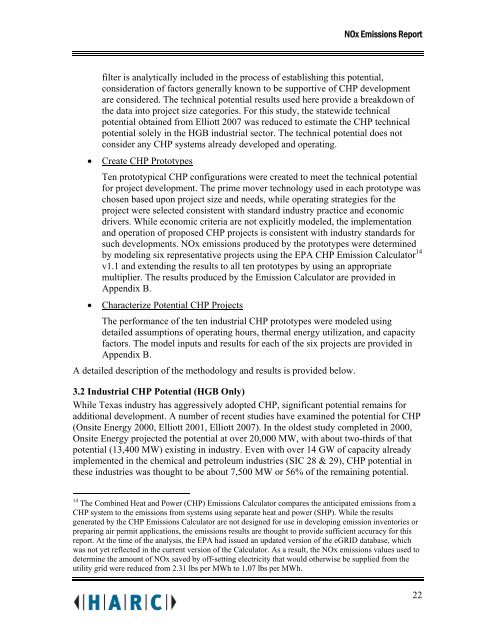NOx Emissions Impacts from Widespread Deployment of CHP in ...
NOx Emissions Impacts from Widespread Deployment of CHP in ...
NOx Emissions Impacts from Widespread Deployment of CHP in ...
You also want an ePaper? Increase the reach of your titles
YUMPU automatically turns print PDFs into web optimized ePapers that Google loves.
<strong>NOx</strong> <strong>Emissions</strong> Report<br />
filter is analytically <strong>in</strong>cluded <strong>in</strong> the process <strong>of</strong> establish<strong>in</strong>g this potential,<br />
consideration <strong>of</strong> factors generally known to be supportive <strong>of</strong> <strong>CHP</strong> development<br />
are considered. The technical potential results used here provide a breakdown <strong>of</strong><br />
the data <strong>in</strong>to project size categories. For this study, the statewide technical<br />
potential obta<strong>in</strong>ed <strong>from</strong> Elliott 2007 was reduced to estimate the <strong>CHP</strong> technical<br />
potential solely <strong>in</strong> the HGB <strong>in</strong>dustrial sector. The technical potential does not<br />
consider any <strong>CHP</strong> systems already developed and operat<strong>in</strong>g.<br />
• Create <strong>CHP</strong> Prototypes<br />
Ten prototypical <strong>CHP</strong> configurations were created to meet the technical potential<br />
for project development. The prime mover technology used <strong>in</strong> each prototype was<br />
chosen based upon project size and needs, while operat<strong>in</strong>g strategies for the<br />
project were selected consistent with standard <strong>in</strong>dustry practice and economic<br />
drivers. While economic criteria are not explicitly modeled, the implementation<br />
and operation <strong>of</strong> proposed <strong>CHP</strong> projects is consistent with <strong>in</strong>dustry standards for<br />
such developments. <strong>NOx</strong> emissions produced by the prototypes were determ<strong>in</strong>ed<br />
by model<strong>in</strong>g six representative projects us<strong>in</strong>g the EPA <strong>CHP</strong> Emission Calculator 14<br />
v1.1 and extend<strong>in</strong>g the results to all ten prototypes by us<strong>in</strong>g an appropriate<br />
multiplier. The results produced by the Emission Calculator are provided <strong>in</strong><br />
Appendix B.<br />
• Characterize Potential <strong>CHP</strong> Projects<br />
The performance <strong>of</strong> the ten <strong>in</strong>dustrial <strong>CHP</strong> prototypes were modeled us<strong>in</strong>g<br />
detailed assumptions <strong>of</strong> operat<strong>in</strong>g hours, thermal energy utilization, and capacity<br />
factors. The model <strong>in</strong>puts and results for each <strong>of</strong> the six projects are provided <strong>in</strong><br />
Appendix B.<br />
A detailed description <strong>of</strong> the methodology and results is provided below.<br />
3.2 Industrial <strong>CHP</strong> Potential (HGB Only)<br />
While Texas <strong>in</strong>dustry has aggressively adopted <strong>CHP</strong>, significant potential rema<strong>in</strong>s for<br />
additional development. A number <strong>of</strong> recent studies have exam<strong>in</strong>ed the potential for <strong>CHP</strong><br />
(Onsite Energy 2000, Elliott 2001, Elliott 2007). In the oldest study completed <strong>in</strong> 2000,<br />
Onsite Energy projected the potential at over 20,000 MW, with about two-thirds <strong>of</strong> that<br />
potential (13,400 MW) exist<strong>in</strong>g <strong>in</strong> <strong>in</strong>dustry. Even with over 14 GW <strong>of</strong> capacity already<br />
implemented <strong>in</strong> the chemical and petroleum <strong>in</strong>dustries (SIC 28 & 29), <strong>CHP</strong> potential <strong>in</strong><br />
these <strong>in</strong>dustries was thought to be about 7,500 MW or 56% <strong>of</strong> the rema<strong>in</strong><strong>in</strong>g potential.<br />
14 The Comb<strong>in</strong>ed Heat and Power (<strong>CHP</strong>) <strong>Emissions</strong> Calculator compares the anticipated emissions <strong>from</strong> a<br />
<strong>CHP</strong> system to the emissions <strong>from</strong> systems us<strong>in</strong>g separate heat and power (SHP). While the results<br />
generated by the <strong>CHP</strong> <strong>Emissions</strong> Calculator are not designed for use <strong>in</strong> develop<strong>in</strong>g emission <strong>in</strong>ventories or<br />
prepar<strong>in</strong>g air permit applications, the emissions results are thought to provide sufficient accuracy for this<br />
report. At the time <strong>of</strong> the analysis, the EPA had issued an updated version <strong>of</strong> the eGRID database, which<br />
was not yet reflected <strong>in</strong> the current version <strong>of</strong> the Calculator. As a result, the <strong>NOx</strong> emissions values used to<br />
determ<strong>in</strong>e the amount <strong>of</strong> <strong>NOx</strong> saved by <strong>of</strong>f-sett<strong>in</strong>g electricity that would otherwise be supplied <strong>from</strong> the<br />
utility grid were reduced <strong>from</strong> 2.31 lbs per MWh to 1.07 lbs per MWh.<br />
22
















